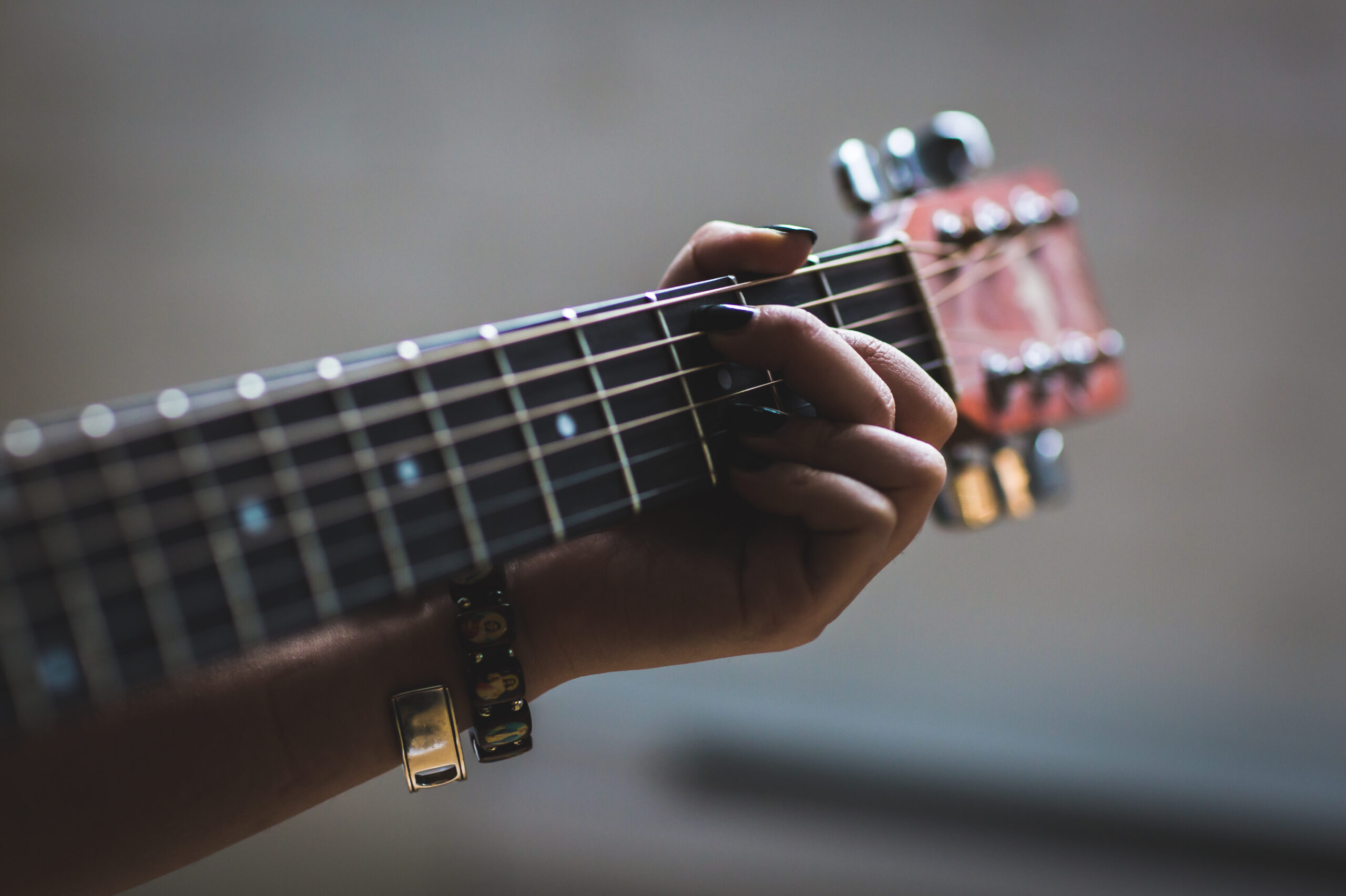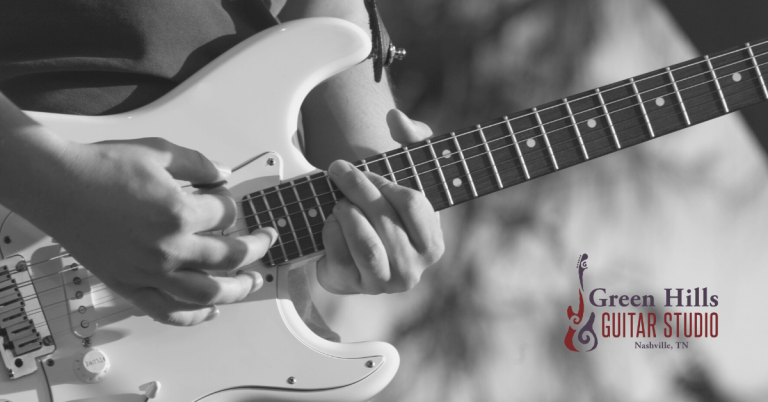The Beginner’s Guide to Learning Guitar Through Songs
Learning the guitar is an exciting adventure that opens up a new world of musical enjoyment, understanding, and creativity.
Whether your dream has always been to learn and play your favorite songs or you’re just starting to explore your creative interests, the guitar offers a versatile and accessible way to grow personally as well.
While the learning process might seem overwhelming at first, starting with songs can be an incredibly effective and enjoyable approach for beginners.
In this comprehensive guide, we’ll delve into the process of learning guitar as a newcomer and why beginning with songs is a fantastic choice.
Where Should a Beginner Guitarist Start?
Starting your journey to learn the guitar as a beginner can quickly feel like you have opened a door into an endless maze. Initially, the journey might feel overwhelming, with a myriad of chords, techniques, and musical theories to absorb.
However, remember that every guitarist and songwriter started from scratch. The process is not only achievable but also immensely rewarding.
Learning songs by your favorite guitarists and bands is a great place to start. This will make the maze more manageable and keep you on track. Studying songs informs you of your proficiencies and areas that need work.
Chords that appear simple on paper can prove challenging to form initially. But don’t worry—every chord you learn, every song you conquer, and every melody you learn to hear and play properly contributes to your growth as a guitarist and songwriter.
Patience, practice, and perseverance are your greatest allies on this journey. Being consistent and disciplined with your approach will get you there.
5 Benefits of Learning Songs When Learning Guitar
Choosing to learn guitar through songs offers distinct advantages over a sole focus on music theory. While theory provides the groundwork, songs inject your learning experience with practicality and motivation.
With songs, you’re not merely deciphering notes; you’re translating emotions into tangible melodies.
Through songs, you naturally grasp chord changes and rhythmic intricacies, truly absorbing the essence of music. It involves a blend of hand movements and strumming that theory alone cannot replicate.
Songs also provide gratifying milestones, such as conquering challenging chord changes or mastering a riff, boosting your determination to progress.
Furthermore, this approach refines your musical ear, enhancing your ability to listen closely and align your instrument accordingly. This comprehensive skill set propels you beyond theoretical boundaries, enabling you to interpret and innovate seamlessly.
Learning guitar through songs isn’t just about education—it’s an explorative journey that transforms theory into artistry, amplifying your growth as a guitarist.
Here are five benefits of learning songs when learning to play guitar:
1. Improve Engagement and Motivation
Learning songs you love enables you to connect emotionally with the music, fostering motivation and excitement.
The joy of recognizing familiar rhythms, progressions, and melodies as you play them is a powerful driving force that keeps you returning to your guitar.
You get immediate feedback on your progress!
2. Apply Techniques in a Musical Context
Songs offer a treasure trove of techniques waiting to be explored. They encompass various strumming patterns, chord transitions, fingerpicking techniques, and more.
Learning songs allow you to practice these techniques within a real musical context, accelerating your progress and helping you understand their practical application and music as a whole.
3. Build Muscle Memory
Muscle memory is a guitarist’s best friend. Repeatedly playing the chords and progressions within songs trains your fingers to remember the movements effortlessly. With practice, your fingers will naturally find their positions, making chord changes smoother and more fluid.
Repetition is your friend!
Also, remember that ear training is part of the process. Your ear will improve as you learn to actively listen to the key, the organization of chords, the structure of a song, and the melody. The muscle memory is in your hands and your ears.
4. Internalize Song Structures
Songs have structures that often include verses, choruses, bridges, and more. Learning complete songs helps you grasp how different parts of a song fit together.
This knowledge becomes invaluable when you start learning lots of songs, memorizing songs, playing in front of others, or composing your own music and collaborating with others.
5. Foster a Sense of Achievement
Completing a song, even a simple one, gives you a tangible sense of accomplishment. It’s a clear demonstration of your progress and a testament to the time spent dedicated to practice. This achievement can boost your confidence and inspire you to tackle more challenging songs.
All of us can use learning songs on guitar as a way to improve our self-esteem and confidence. So yes, take pride in your work and be proud of what you accomplish!
6 Proven Steps Toward Learning Guitar
For budding guitar players, a structured approach to learning helps build clarity and confidence. A meticulously organized method is not just beneficial—it’s essential.
By following these six proven steps, you’ll not only streamline your learning process but also harness a sense of accomplishment with each progression.
Here’s a step-by-step breakdown:
1. Select Appropriate Songs
Begin with songs that match your current skill level. Look for tunes with relatively simple chord progressions and strumming patterns. I will provide multiple playlists that offer a great selection of beginner-friendly songs to consider.
2. Master Chords and Progressions
Focus on learning and listening to the chords needed for your chosen songs. Remember, we are working on ear training here as well. Try to pay attention to the way each chord sounds as you play it.
Practice transitioning between these chords until you can switch smoothly. Start at a slower tempo if necessary, and it is necessary and not a failure or lack of potential, and gradually increase speed as your fingers become more accustomed to the movements.
Be kind to yourself. You are learning something new! It’s not about perfection in the short term.
3. Learn Strumming Patterns or Fingerpicking
Depending on the song, you’ll encounter various strumming patterns or fingerpicking techniques. Study the rhythm and timing of each song’s pattern, and practice it separately before integrating it with the chords. I think it’s best to learn how to count, subdivide and understand time signatures.
Just guessing and hoping it all works out isn’t a good plan. You are setting yourself up for frustration and failure. I believe working with good transcriptions and chord charts is best.
I’m not a fan of looking at lyric sheets with chord changes written above the words. Our eyes focus on the lyric and neglect the strumming and rhythmic patterns.
Practicing simplified strum patterns and rhythms of songs with a metronome is best. Then, as you learn to hear the chord changes, making the transitions in time, you can add to the strum pattern and work your way closer to the parts you hear in the recorded song.
Set yourself up for success!
Be patient with yourself, and be realistic. Making assumptions and having unrealistic expectations will always cause problems, whether it’s in an athletic pursuit, learning guitar, planning a trip, or working on any other life project.
4. Break Down into Sections
Divide the song into manageable sections—verse, chorus, bridge, etc. Practice each section individually before attempting to play the entire song.
This approach makes the learning process less overwhelming and allows you to focus on refining specific transitions and chord changes.
Work on the stuff that is hard.
Your brain and ego will always push you to do what’s easy…and keep doing it again and again! Our brains are wired to assess threats and take a path of least resistance.
Yes, learning barre chords is challenging, so many beginners avoid them. Then we get into a cycle of despair, self-judgment, and procrastination.
Doing difficult things is good for us. If we aren’t feeling awkward or a bit exposed and uncomfortable, we aren’t learning and growing.
5. Prioritize Consistency and Precision
Remember that learning guitar is a pursuit and a process, not an overnight happening or a 4-week, short-term goal. It should be fun, and it should be a bit challenging and rewarding.
Begin practicing at a slow tempo, gradually increasing the speed as you become more comfortable.
This approach prevents frustration and helps build accuracy and consistency. Make a realistic practice schedule, and keep showing up to it.
6. Repeat, Refine, and Reflect
Repetition is crucial for solidifying your skills and memorizing chords and chord progressions. Remember, we are also learning about song structure, keys, and ear training.
We are also developing each hand individually. There’s a lot going on!
Regularly practice the songs to develop muscle memory. As you become more proficient, concentrate on refining the dynamics, transitions, and nuances of your performance. I also encourage you to work on more than one song at a time.
At this stage, it’s not about the roller coaster ride of perfection. Keep it simple and realistic.
We are just trying to learn some chords, learn some rhythms and strum patterns and put it together and move forward. Exposing yourself to different tempos, grooves, time signatures, and grouping of chords is a good thing.
Having a warm-up exercise or two that focuses on each finger individually will help them work together as a whole. Again, slow and steady! Speed is the easiest part and will come with time.
Not paying attention to technical issues and going too fast too soon will catch up with you, and you will have to go back a few steps and re-learn some skills you overlooked by rushing through too quickly. Not fun and not productive.
The Coda
Learning the guitar as a beginner is a really fun and rewarding journey that demands dedication, practice, and a touch of patience. Starting with songs not only makes the learning process more enjoyable but also helps you develop essential skills and techniques.
As you embark on this musical adventure, keep in mind that every chord you strum and every song you conquer brings you closer to becoming the guitarist you aspire to be.
So, pick up your guitar, choose your first song, and let the music guide you on an incredible journey of musical and self-discovery, and self-expression. Have fun, and I’ll see you soon!
Happy guitar-ing!
If you are looking for a really good beginning course for guitarists and songwriters, I suggest the Absolute Beginners Guitar Course.
A great co-companion course to begin learning the guitar neck, moving around, and improving hand position and the ability to play barre chords would be our Power Chord Course.






